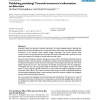Free Online Productivity Tools
i2Speak
i2Symbol
i2OCR
iTex2Img
iWeb2Print
iWeb2Shot
i2Type
iPdf2Split
iPdf2Merge
i2Bopomofo
i2Arabic
i2Style
i2Image
i2PDF
iLatex2Rtf
Sci2ools
BMCBI
2007
2007
Publishing perishing? Towards tomorrow's information architecture
Scientific articles are tailored to present information in human-readable aliquots. Although the Internet has revolutionized the way our society thinks about information, the traditional text-based framework of the scientific article remains largely unchanged. This format imposes sharp constraints upon the type and quantity of biological information published today. Academic journals alone cannot capture the findings of modern genome-scale inquiry. Like many other disciplines, molecular biology is a science of facts: information inherently suited to database storage. In the past decade, a proliferation of public and private databases has emerged to house genome sequence, protein structure information, functional genomics data and more; these digital repositories are now a vital component of scientific communication. The next challenge is to integrate this vast and ever-growing body of information with academic journals and other media. To truly integrate scientific information we must...
| Added | 08 Dec 2010 |
| Updated | 08 Dec 2010 |
| Type | Journal |
| Year | 2007 |
| Where | BMCBI |
| Authors | Michael R. Seringhaus, Mark B. Gerstein |
Comments (0)

